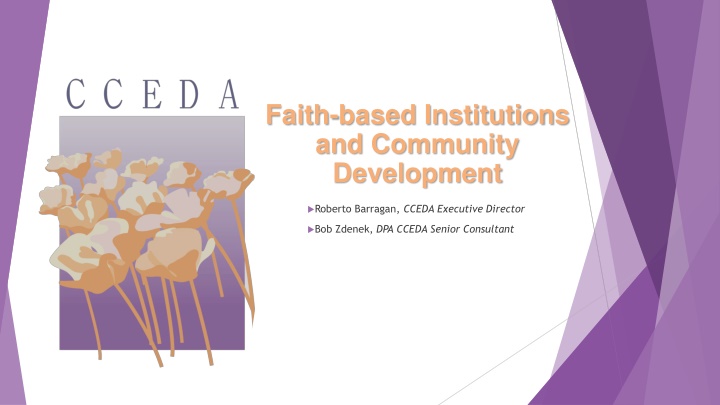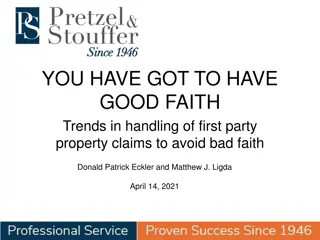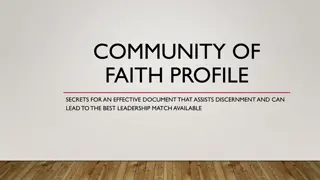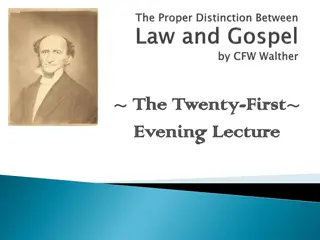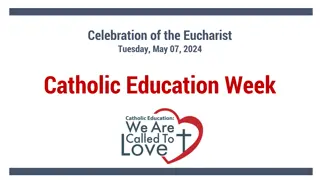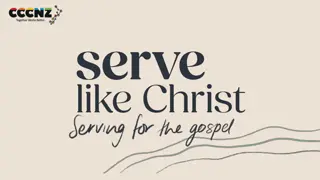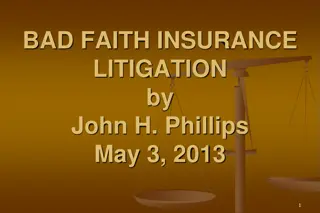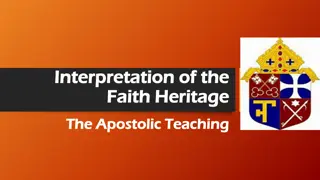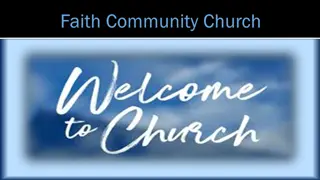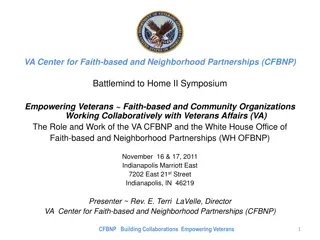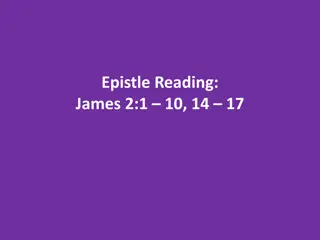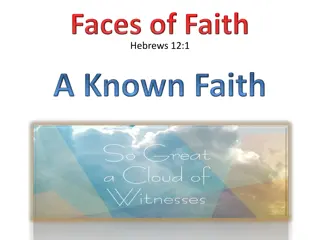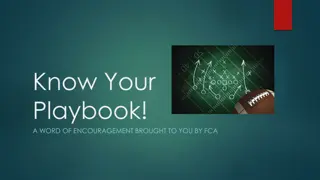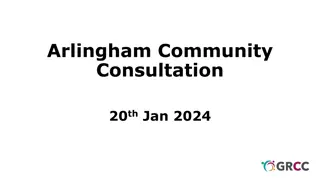Faith-Based Community Development Initiatives
This content explores the history, significance, and major initiatives of faith-based community development, focusing on the role of institutions such as churches and community development corporations in revitalizing neighborhoods. It highlights the involvement of faith-based organizations, federal grants, major initiatives, and the characteristics of Community Development Corporations.
Download Presentation

Please find below an Image/Link to download the presentation.
The content on the website is provided AS IS for your information and personal use only. It may not be sold, licensed, or shared on other websites without obtaining consent from the author.If you encounter any issues during the download, it is possible that the publisher has removed the file from their server.
You are allowed to download the files provided on this website for personal or commercial use, subject to the condition that they are used lawfully. All files are the property of their respective owners.
The content on the website is provided AS IS for your information and personal use only. It may not be sold, licensed, or shared on other websites without obtaining consent from the author.
E N D
Presentation Transcript
Faith-based Institutions and Community Development Roberto Barragan, CCEDA Executive Director Bob Zdenek, DPA CCEDA Senior Consultant
CALIFORNIA COMMUNITY ECONOMIC DEVELOPMENT ASSOCIATION (CCEDA) serves as a clearinghouse for information and action that advances the field of community economic development through training and continuing education, technical assistance, and advocacy on public policy. All CCEDA s activities serve our membership organizations actively engaged in revitalizing California s neighborhoods, including resident driven community development corporations, local governments, community action agencies and faith-based institutions.
Importance of community People, leadership, and resources Why Faith-based community development? Similar values Focus on community revitalization/ search for comprehensiveness. Strong focus on people of color Community controlled and led
Faith-based Community Development history The role of the African-American church and immigrant churches. Community development corporations grew out of War on Poverty and have deep roots in the faith-based community. Community organizing is rooted in local congregations (IAF). Some congregations started CDC s (Abyssian Baptist, FAME CDC, Bethel New Life, Nueva Esperanza, New Community Corporation). Churches were able to use property to finance community economic development Role of the church in land ownership (Southern Cooperative Development Fund) and housing (Manna Inc. Jubilee House).
Major Faith-based Community Initiatives Community-organizing through congregations (IAF, Gamaliel, PICO, DART) iron rule of organizing Congregations as partners in community development. An initiative sponsored by Ford Foundation and Lilly Endowment. 28 initiatives reported raising $4.3 million from local religious sources, and $700,000 from national sources. Federal Government Office of Compassionate Capital provided a lot of grants during Bush II Era and Obama continued them for awhile Denominational efforts- U.S. Catholic Conference Campaign for Human Development and Protestant efforts have provided long-term support. Christian Community Development Association formed in the early 1990 s under the leadership of Reverend John Perkins- 3 R s- relocation, reconciliation, redistribution.
What is a CDC (Community Development Corporation)? Goal and vision- To revitalize a distressed community to benefit local residents and businesses predominately in communities of color. Characteristics- volunteer governed, professional staff, entrepreneurial, technical expertise, strong partnership skills, ability to raise diverse resources, long-term perspective Structure- 501(c)3 organization with subsidiaries. Experience in incorporating CDCs. Loan funds, housing partnerships, commercial real estate partnerships are examples of subsidiaries. Programs- affordable housing, economic development (small businesses, commercial revitalization), workforce development, community facilities, services.
What is a CDC? - Strategies Affordable housing- Rental housing, homeownership, limited equity coops, manufactured housing, etc. As of 2009, CDC s had developed over 1.6 million units of housing and 96,000 per year. Minority small business- Financing, marketing, real estate development. Micro-loan funds and larger investment funds. Some CDC s establish community-development financial institutions (CDFIs). Commercial and industrial development- facility, marketing, and financing. Business Incubators as an example. Workforce development- Connecting job trainees to jobs that offer career mobility. Working with at-risk youth through YouthBuild and other initiatives. Community facilities- Child care, education, community service centers. Placemaking and streetscapes- Celebrating the culture(s) of the community. Events, art and culture. Organizational capacity- Strong representative board that governs CDC, and professional staff that is diverse and manages complex community development initiatives. Development process- Ability to mobilize and assembly diverse funding sources within a project. Some projects require more than 10 funding sources. The development process will be discussed in the next webinar.
What is a CDC? - Data Importance of data systems and outcomes- 1. Community development is complex and need to be able to track development 2. Accurate financial data will enable you to stay within the project parameters. 3. Outcomes are critical to ensure you are making a difference A. Outputs, jobs, houses, businesses, B. Outcomes- improved lives, opportunities, how is the community better.
What is a CDC? - Community Engagement Community engagement is what distinguishes a CDC from other organizations. CDCs engage a diverse array of stakeholders: Congregation members- Community residents and leaders- Business leaders and owners- Other non-profit organizations and civic institutions- Local government- The goal is to develop shared vision, leadership, resources, and support.
CDC Issues and Challenges 1. Comprehensiveness - responding to the needs of the community. Can t do everything. 2. Serving congregational members versus whole community. Can be a perception issue. 3. Clergy and technical expertise - challenging to be a clergy member and community development professional 4. Accessing resources - While congregations can launch CDCs, the CDC will need significant resources. 5- Single congregation versus collaboration - potential leadership challenges 6. Board and staff - You need both and functioning effectively. Board has steward, accountability, values, and expertise.
Summary CDC s offer a vehicle for significant impact in low-income communities. 1. Long history of Faith-based community development. You are not alone! 2. CDC s are complex and require attention and concentration of resources. 3. There is a lot of expertise and experience with CDC s. 4. Learn and grow your ecosystem and stay focused on your competencies (next session). 5. CCEDA is a really important resource for your work. 6.
CCEDA Technical Assistance Consultants will help you determine if you are real estate ready for acquisition/expansion. Consultants will help you determine the space that fits your mission and your financial ability. Consultants will help you access the resources needed to determine and ensure project success and move your project forward.
FAITH-BASED COMMUNITY DEVELOPMENT F U N D I N G A N D PA R T N E R S H I P O P P O R T U N I T I E S F O R F A I T H - B A S E D C D C S W E B I N A R 2 , J A N U A RY 1 3T H, 2 0 2 2
COMMUNITY DEVELOPMENT ECOSYSTEM- v. Additional outside resources needed for ecosystem iv. Knowledge and gaps in community development vi. Other key community- based organizations. Seasoned compared to inexperienced organizations Associations and networks repositories of information Technical assistance and intermediary organizations Assess gaps of information and financing and how to acquire them Forge partnerships which are becoming more important in community dev. CAA s, health care, education, workforce, small business, and others. Applied research programs can be helpful. Faith-based partners
I. Shared mission and vision of community economic development FAITH-BASED INSTITUTIONS PURSUING COMMUNITY ECONOMIC DEVELOPMENT- WHAT IS UNIQUE ii. income communities. Faith-based congregations have members and resources in low- iii. Connection to leaders both religious and secular communities. iv. and usually better to separate faith-based from community developments activities for programmatic and funding purposes Congregations don t have the community development expertise v. maintained a relationship through board and some shared resources, notably office, in-kind, and seed capital . Churches and congregations have often started CDCs and vi. A balancing act between religious purpose and values and community development objectives. Have to be careful about perception of church and state issues.
Identify existing CDCs and explore joint planning and project opportunities. Identify FAITH-BASED INSTITUTIONS CONT: Develop a short-term project where you can demonstrate success Develop Utilize outside resources such as CCEDA and private sector resources. Utilize
MAJOR FUNDING SOURCES FOR FAITH- BASED COMMUNITY DEVELOPMENT 1. Community development intermediaries- LISC, Enterprise, Capital Impact Partners, NeighborWorks, and others 2. Community development financial institutions (CDFIs)- national, regional, and local 3. Financial institutions- CRA- grants, loans, and in-kind support 4. Private foundations- community foundations, specialized funders, and national foundations 5. Corporate Foundations 6. Don t forget faith-based partners!
MAJOR FUNDING SOURCES FOR FAITH- BASED COMMUNITY DEVELOPMENT CONT: 7. Learn about funding cycles, and requirements 8. Develop or contract development expertise including research and writing proposals. 9. Personal relationships very important in securing funding especially non-governmental sources.
FUNDRAISING GOALS: BUILDING A STRONG ORGANIZATION Fundraising is a very complicated strategy requiring a lot of different resources I. Stable operational financial support- Can t move forward without a strong base- Operational funding for at least 2 years and 3 FTEs. Need time to develop projects ii. Pre-development and planning including land assemblage- Pre-development Acquisition and site control Architectural and engineering Assembling the financial resources iii. Project based financing Pre-development Construction financing Permanent financing
FUNDRAISING GOALS: BUILDING A STRONG ORGANIZATION iv. Permanent financing- Sources Reserve funds Management and service expenses v. Lending capital- Small business lending Small business technical assistance Revolving loan funds and keeping funds available vi. Technical assistance- Operational Project-based Technical assistance for finance and services
PARTNERSHIPS AS A COMMUNITY DEVELOPMENT STRATEGY 1. Complexity of community development benefits from other organizations. 2. receive fees for development which is a win-win. They can also manage properties. Seasoned organizations with significant capacity can work with newer organizations and 3. Community Development. Core competencies in community development. There are 12 identified in Navigating 4. partnerships. Play to comparative advantage, your strengths, and acquire other strengths through
PARTNERSHIPS AS A COMMUNITY DEVELOPMENT STRATEGY 5. Develop an initial partnership that is doable. 6. organizational functions. Funders are encouraging partnerships. Look for patient funding to pay for backbone 7. (MOUs) to shared staff to Joint Ventures. Find the right approach. There are multiple partnership strategies from Memorandum s of Understanding 8. Get to know CDCs in your area and see which might be partners. 9. Utilize consultants that have worked on structuring partnerships.
PUBLIC SECTOR FUNDING 1. Federal government pass-throughs- CDBG, HOME, LIHTC 2. Federal economic development programs- Office of Community Services Economic Development Administration Small Business Administration Others.
GoBiz: Small Business Finance Center and IBank California Housing and Community Development Department (HCD): has a variety of resources for housing projects, including HOME, Multifamily Housing Program (MHP), No Place Like Home, Veterans and Affordable Housing, among many others PUBLIC SECTOR FUNDING: STATE Community Development Block Grant (CDBG): Housing Program Activities, including Homeownership Assistance and Housing Rehab for Single Family Homes The AHSC Program: funds land-use, housing, transportation, and land preservation projects to support infill and compact development that reduce greenhouse gas ("GHG") emissions State Treasurer: Low Income Housing Tax Credits The California Tax Credit Allocation Committee ( Committee or CTCAC ) administers the low- income housing tax credit program to encourage private investment in affordable rental housing for households meeting certain income requirements. Credits are available for new construction projects or existing properties undergoing rehabilitation.
CCEDA AND SUMMARY 1. CCEDA is committed to helping faith-based congregations launch CDCs and other community development initiatives 2. CCEDA has significant expertise in fundraising 3. CCEDA can forge partnerships between faith-based and other organizations especially experienced organizations helping newer ones. 4. There are faith-based resources that can be deployed for community development. 5. The next webinar will focus on (please add) and talk about the in- person session.
CCEDA CONTACTS 1. Roberto Barragan, Executive Director Roberto@cceda.com Roberto@cceda.com 2. Elena Frias, Program Director elena@cceda.com elena@cceda.com 3. Elias Garcia, Training Coordinator elias@cceda.com elias@cceda.com 4. Bob Zdenek, Senior Advisor/Consultant CCEDA Robert.Zdenek@verizon.net Robert.Zdenek@verizon.net 5. Dawn Perkins, Membership and Marketing Coordinator dawn@cceda.com dawn@cceda.com
